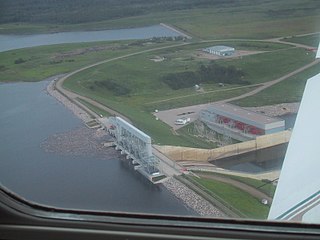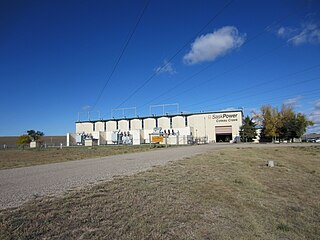
Hydroelectricity, or hydroelectric power, is electricity generated from hydropower. Hydropower supplies one sixth of the world's electricity, almost 4,500 TWh in 2020, which is more than all other renewable sources combined and also more than nuclear power. Hydropower can provide large amounts of low-carbon electricity on demand, making it a key element for creating secure and clean electricity supply systems. A hydroelectric power station that has a dam and reservoir is a flexible source, since the amount of electricity produced can be increased or decreased in seconds or minutes in response to varying electricity demand. Once a hydroelectric complex is constructed, it produces no direct waste, and almost always emits considerably less greenhouse gas than fossil fuel-powered energy plants. However, when constructed in lowland rainforest areas, where part of the forest is inundated, substantial amounts of greenhouse gases may be emitted.

The Bełchatów Power Station is a coal-fired power station near Bełchatów, Poland. It is the largest thermal power station in Europe. The power station is owned and operated by PGE GiEK Oddział Elektrownia Bełchatów, a subsidiary of Polska Grupa Energetyczna.

Coal pollution mitigation, sometimes labeled as clean coal, is a series of systems and technologies that seek to mitigate health and environmental impact of burning coal for energy. Burning coal releases harmful substances that contribute to air pollution, acid rain, and greenhouse gas emissions. Mitigation includes precombustion approaches, such as cleaning coal, and post combustion approaches, include flue-gas desulfurization, selective catalytic reduction, electrostatic precipitators, and fly ash reduction. These measures aim to reduce coal's impact on human health and the environment.
Saskatchewan Power Corporation, operating as SaskPower, is the principal electric utility in Saskatchewan, Canada. Established in 1929 by the provincial government, it serves more than 550,000 customers and manages nearly $13 billion in assets. SaskPower is a major employer in the province with over 3,100 permanent full-time staff located in approximately 70 communities.
The natural environment, commonly referred to simply as the environment, is all living and non-living things that occur naturally on Earth or some part of it. This includes complete ecological units that function as natural systems without massive human intervention, including all vegetation, animals, microorganisms, rocks, atmosphere and natural phenomena that occur within their boundaries. And it includes universal natural resources and physical phenomena that lack clear-cut boundaries, such as air, water, and climate, as well as energy, radiation, electric charge, and magnetism, not originating from human activity.
Atikokan Generating Station is a biomass power plant owned by Ontario Power Generation (OPG) located 8 km (5 mi) north of Atikokan, Ontario. The plant employs 90 people. The Atikokan Generating Station began operation as a coal fired station in 1985 and underwent an overhaul in the autumn of 2003.
Coal reserves in Canada rank 13th largest in the world at approximately 10 billion tons, 0.6% of the world total. This represents more energy than all of the oil and gas in the country combined. The coal industry generates CDN$5 billion annually. Most of Canada's coal mining occurs in the West of the country. British Columbia operates 9 coal mines, Alberta nine, Saskatchewan three and New Brunswick one. Nova Scotia operates several small-scale mines, Westray having closed following the 1992 disaster there.

Boundary Dam Power Station is the largest coal fired station owned by SaskPower, located near Estevan, Saskatchewan, Canada.
Queen Elizabeth Power Station is a natural gas-fired station owned by SaskPower, located in Saskatoon, Saskatchewan, Canada. The station was called the South Saskatchewan River Generating Station but renamed the Queen Elizabeth Power Station at the time of commissioning in 1959.

Poplar River Power Station is a coal-fired station owned by SaskPower, located near Coronach, Saskatchewan, Canada, approximately 8 kilometres (5.0 mi) from the Canada–US border.

Nipawin Hydroelectric Station is a hydroelectric station owned by SaskPower in the Canadian province of Saskatchewan. It is about 5 kilometres (3.1 mi) upstream from the town of Nipawin at the Francois-Finlay Dam. The dam, which was completed in 1986, crosses the Saskatchewan River creating Codette Lake, which supplies the water for the power station. The dam was named after James Finaly and Francois LeBlanc who had "constructed a trading post on the lower terrace of Bushfield Flats immediately upstream of the power station".

E.B. Campbell Hydroelectric Station is a hydroelectric station on the Saskatchewan River owned by SaskPower, located near Carrot River, Saskatchewan, Canada. The dam created the artificial Tobin Lake. The station is named after Bruce Campbell, a former president of SaskPower who was also the assistant chief engineer during the construction of the station. Until 1988, it was named Squaw Rapids Dam.

Coteau Creek Hydroelectric Station is a hydroelectric station owned by SaskPower, located near Danielson Provincial Park about 100 kilometres (62 mi) south-west of Saskatoon, between the towns of Outlook and Elbow. The station is on the South Saskatchewan River and draws water from the Gardiner Dam and is named after a nearby tributary to the South Saskatchewan River.
Greenhouse gas emissions are one of the environmental impacts of electricity generation. Measurement of life-cycle greenhouse gas emissions involves calculating the global warming potential of energy sources through life-cycle assessment. These are usually sources of only electrical energy but sometimes sources of heat are evaluated. The findings are presented in units of global warming potential per unit of electrical energy generated by that source. The scale uses the global warming potential unit, the carbon dioxide equivalent, and the unit of electrical energy, the kilowatt hour (kWh). The goal of such assessments is to cover the full life of the source, from material and fuel mining through construction to operation and waste management.
Sundance Power Station is a gas fired station owned by TransAlta Corp., located 70 km west of Edmonton, Alberta, Canada on Lake Wabamun. It comprised six units ; both 280 MW units were taken out of service in mid-December 2010 and determined to be beyond economic repair. A legal battle between the owner of the PPA (TransCanada) ensued, which forced the two units to come back on line after replacement of the two boiler units. As of Dec 2013 both units had returned to production.

Genesee Generating Station is a thermal power station station owned by Capital Power Corporation, located near Genesee, Alberta, Canada; 71 km southwest of Edmonton, Alberta. The cooling pond covers 735 hectares. The pond is topped up with water from the North Saskatchewan River. As of June 18, 2024, all units are now 100% natural gas-fueled.

McDonald Lake, also known as Rafferty Reservoir, is a reservoir in the south-eastern part of the Canadian province of Saskatchewan. It was created when the Rafferty Dam was built on the Souris River in 1994. Before the dam was built that flooded the Souris Valley, McDonald Lake was a small lake and marsh on the valley floor adjacent to the Souris River.

Coal has been mined in Saskatchewan ever since the 1850s when it was used as a source of heat for the early Pioneers in the treeless Great Plains. Today, coal is still mined in Saskatchewan, but it is primarily used to generate electricity.












